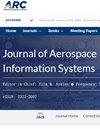挖掘机场航站楼空域流行飞行模式的分层方法
IF 1.5
4区 工程技术
Q2 ENGINEERING, AEROSPACE
引用次数: 0
摘要
由于机场终端空域飞行模式的多样性,以及从同一跑道或走廊进出的不同飞行模式具有很高的全球相似性,目前的主流方法难以实现良好的聚类。为此,本文首先构建了截断动态时间翘曲(TDTW)轨迹相似性度量,以表征具有高全局相似性和大局部差异性的不同轨迹模式。在此基础上,提出了一种层次化的飞行模式挖掘方法,根据不同的特征将其划分为四层。该方法的前三层根据起降类型、跑道和走廊对轨迹进行分类;第四层则采用了基于TDTW的[公式:见文]-媒质聚类方法,使挖掘过程更加可控,更符合实际操作。实验结果表明,与动态时间规整相比,该方法获得的聚类的类内紧密度和类间分离度分别降低了44.6%和20.1%,整体性能提高了54.1%。得到了更加精细合理的飞行模式。本文章由计算机程序翻译,如有差异,请以英文原文为准。
Hierarchical Method for Mining a Prevailing Flight Pattern in Airport Terminal Airspace
Due to the variety of flight patterns in airport terminal airspace, as well as the high global similarity of different flight patterns entering and leaving from the same runway or corridor, it is difficult for current mainstream methods to achieve good clustering. To this end, this paper first constructs a truncated dynamic time warping (TDTW) trajectory similarity measurement to characterize different trajectory patterns with high global similarity and large local differences. Furthermore, a hierarchical flight pattern mining method is proposed, which is divided into four layers according to different characteristics. The first three layers of the method classify trajectories according to takeoff and landing types, runways, and corridors; whereas the fourth layer uses a [Formula: see text]-medoid clustering method based on TDTW, thereby making the mining process more controllable and in line with actual operation. Compared to dynamic time warping, the experimental results show that the intraclass compactness and interclass separation of the cluster obtained by the proposed method have decreased and increased by 44.6 and 20.1%, respectively, and the overall performance has improved by 54.1%. More refined and reasonable flight patterns have been obtained.
求助全文
通过发布文献求助,成功后即可免费获取论文全文。
去求助
来源期刊

Journal of Aerospace Information Systems
ENGINEERING, AEROSPACE-
CiteScore
3.70
自引率
13.30%
发文量
58
审稿时长
>12 weeks
期刊介绍:
This Journal is devoted to the dissemination of original archival research papers describing new theoretical developments, novel applications, and case studies regarding advances in aerospace computing, information, and networks and communication systems that address aerospace-specific issues. Issues related to signal processing, electromagnetics, antenna theory, and the basic networking hardware transmission technologies of a network are not within the scope of this journal. Topics include aerospace systems and software engineering; verification and validation of embedded systems; the field known as ‘big data,’ data analytics, machine learning, and knowledge management for aerospace systems; human-automation interaction and systems health management for aerospace systems. Applications of autonomous systems, systems engineering principles, and safety and mission assurance are of particular interest. The Journal also features Technical Notes that discuss particular technical innovations or applications in the topics described above. Papers are also sought that rigorously review the results of recent research developments. In addition to original research papers and reviews, the journal publishes articles that review books, conferences, social media, and new educational modes applicable to the scope of the Journal.
 求助内容:
求助内容: 应助结果提醒方式:
应助结果提醒方式:


